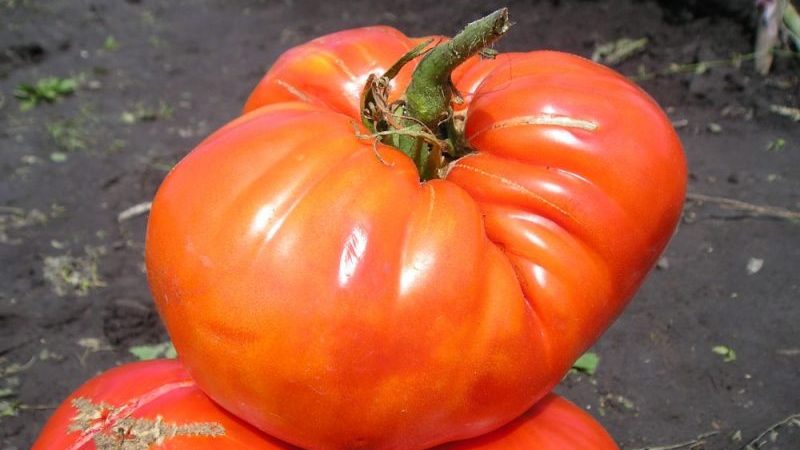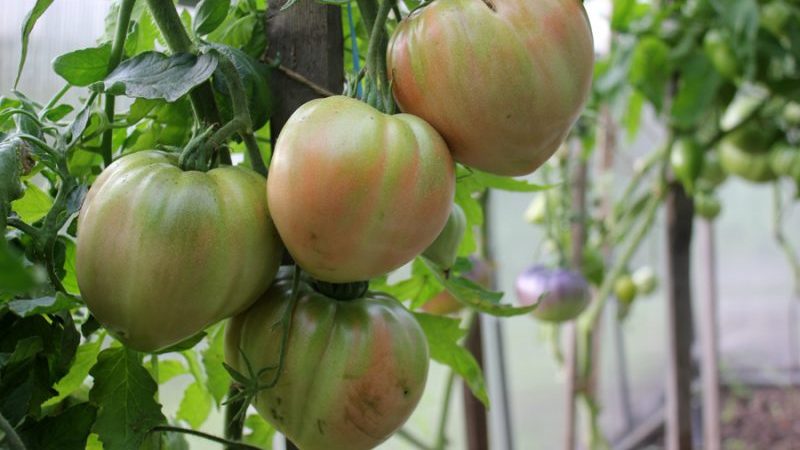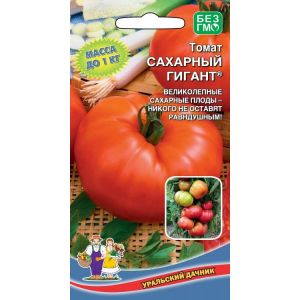We collect 5-6 kg of tomatoes from a bush, growing a tomato "Sugar giant"
The name of the tomato, Sugar Giant, expresses the eternal dream of a Russian gardener: to grow tasty, sweet and large tomatoes in his dacha so that one can feed the whole family.
The variety is not included in the State Register of Breeding Achievements, but even the old-timers of the arch can envy the popularity of the Sugar Giant. The most frequent words of vegetable growers when describing these tomatoes are exceptional, extraordinary, excellent. And it looks like it's true.
The content of the article
Description of the variety
Tomato Sugar giant belongs to the varieties of "amateur selection", its description differs from different seed producers. The main differences relate to the shape of the fruit and the timing of ripening. Most amateur agronomists refer to this variety as heart-shaped tomatoes with a late ripening period.

Bush
The plant belongs to indeterminate type, reaches a height of 1.8-2 m in greenhouses and 1.5 m in open beds.
The foliage is medium, the leaves are large, dark green. The stems are slender, requiring a garter. The education of the stepsons is moderate.
The first inflorescence is formed above the ninth leaf, the rest grow through two internodes. In each hand, 4-6 fruits are tied. The sugar giant actively forms fruit ovaries regardless of weather conditions.
The fruiting period is long, in greenhouses - until early October, in the open air - until frost.
Fruit characteristics and yield
The sugar giant is a late-ripening species. The first commercial tomatoes ripen 125-130 days from the moment of germination.
Fruits are heart-shaped, red, with dense fleshy pulp and thin skin. The section shows a small number of seed chambers without a rigid core. The fruits are large, their average weight is 300-350 g, when grown in one stem, it can reach 500-600 g. Tomatoes have an excellent taste and high sugar content, but are difficult to store and transport.
The yield of the variety is high: summer residents collect 3-4 kg from a bush, and with proper agricultural technology, a harvest of up to 5-6 kg is possible.
Seed preparation
Regardless of the seed source (own or purchased), to obtain a good harvest before planting, you need to perform three operations.
Rejection
Its goal is to select viable, "full" seeds. To do this, dissolve a teaspoon of salt in a glass of water, place the seed there and mix for 10-15 minutes. Floated seeds are discarded. The mixture with the remaining seeds is filtered, the seeds are washed with clean water.
Disinfection
It is carried out to remove spores of fungi and pathogenic microorganisms. To do this, the seed is soaked in one of the disinfectant solutions for 30 minutes:
- 1% light pink potassium permanganate;
- 3% hydrogen peroxide - accelerates seed germination;
- "Fitosporin" (in accordance with the instructions).
Germination
The calibrated and disinfected seeds are spread on the wet material. To maintain constant humidity, they are covered with plastic wrap and placed in a warm (22-25 degrees) place.
After five days, white roots appear - the seeds are ready for planting.
Planting seedlings
The tomato is grown only by the seedling method.
Soil preparation
The seedling soil should be nutritious, light and breathable. The optimal soil for growing seedlings is a mixture of sod land, sand and peat with the addition of complex fertilizers and a moisture regulator - vermiculite.
There are special mixtures for seedlings of nightshade crops, they already contain a balanced composition of the necessary ingredients and have been disinfected.
If preference is given to your own soil, then it is advisable to form the composition in accordance with the recommendations and be sure to disinfect it.
To do this, use one of three methods:
- Soak the soil with a pink solution potassium permanganate.
- Treat with a solution of brilliant green: 10 drops of the product per 1 liter of water.
- Calcined in an oven at a temperature of 120-150 degrees for at least an hour.
Sowing
With a large number of seedlings, seeds are sown in flat containers with drainage holes or a drainage layer at least 2-3 cm thick. Such plantings must subsequently be dived. The seeding pattern is 4x3 cm with a depth of 1 cm.
If there are few seedlings, then it is better to immediately sow the seeds in separate small containers. As the seedlings grow, they are transplanted by transferring them into larger vessels.
With each transplant, the plant is buried along the lower leaves. This causes additional roots to grow and prevents the seedlings from stretching too long. Three-fold transshipment increases the root system fivefold!
Important! Before filling with soil, containers must be treated with any disinfectant.
Care
Seedlings during the growth period must provide optimal conditions:
- good illumination for at least 10 hours a day, including with special phytolamps;
- temperature regime: 18-25 degrees during the day and 13-17 degrees at night;
- sufficient watering without hitting the stem at the ground surface to avoid blackleg;
- high air humidity, which is provided by humidifiers or daily spraying of plants.
How to grow tomatoes
Seedlings in open ground or in a greenhouse are planted at the age of 60 days.

Landing
An additional condition for planting in open ground is the soil temperature: it must be at least 15 degrees.
To increase the yield by 1.5-2 times, horizontal planting of the seedling with a deepening of the trunk is recommended - this ensures additional root formation.
Plants are planted using this method at a distance of 70-80 cm in a row, row spacing is 30-40 cm, seedlings are planted in a checkerboard pattern.
With the traditional technique, the landing pattern is 60x60 cm.
Care
The sugar giant can easily withstand short-term drying out of the soil, while waterlogging leads to rot and cracking of the fruit.
Weeding and loosening are mandatory procedures for tomato care: their roots should receive as much air as possible. These operations can be reduced by applying mulching soil near bushes. Mowed grass, wood chips, perlite are used as mulch.
In greenhouses, it is recommended to form the Sugar Giant into two trunks, in the open field - into one. Accordingly, constant pinching and garter are required not only of the stems, but also of the brushes.
The sugar giant is very responsive to feeding... Only with sufficient fertilization can a good harvest be expected.
During the growing season, at least three dressings should be carried out:
- Full complex fertilizer 7-10 days after transplanting.
- Before flowering - a phosphorus-potassium mixture with a slight addition of nitrogen.
- Two weeks after the end of flowering - superphosphate and potassium nitrate. During this period, nitrogen fertilizers are prohibited!
In between these dressings, the bushes can be pollinated. wood ash and carry out foliar feeding with superphosphate.

Features and possible difficulties
A distinctive feature of the variety is the beginning of the formation of the upper ovaries only after the ripening of the tomatoes on the lowest (first) cluster. If the first brush is removed at the end of flowering, the period for tying the remaining fruits is noticeably reduced and the tomatoes are more uniform in size.
Due to its high growth and thin stem, the tomato must be tied up and props made under the branches. This will provide additional wind protection if the plant is grown outdoors. Especially large clusters of tomatoes require separate support.
Cracking of ripe fruits during ripening is not a distinctive feature of the variety, but most often it occurs in open ground with unbalanced watering. Greenhouse and greenhouse fruits of the Sweet Giant are not prone to peel breakage. To prevent cracking, the soil is enriched with nitrate and watering is reduced during fruiting.
Diseases and pests
Experienced gardeners use protective measures against nightshade diseases, which include:
- spraying with biofungicides such as "Fitosporin", "Gamair", "Alirin-B", 1% Bordeaux liquid;
- the use of growth stimulants to enhance immunity;
- planting of nursery plants: marigolds, garlic, marigolds, nasturtium.
Constant ventilation of greenhouses helps slow the spread of diseases.
Tomato pests - whitefly, aphids, spider mites - are effectively destroyed by intestinal insecticides: "Fufanon", "Karbofos", "Confidor".
The nuances of growing in an open field and a greenhouse
To extend the growing season of a late-ripening variety in the open field, you can plant seedlings in the soil two weeks earlier, but using temporary shelters from the night cold. They are portable frames and covering material such as spunbond. A month before the onset of the autumn cold, it is necessary to remove new flower ovaries - this will allow the remaining ones to reach a mature state.
The same is done with greenhouse plants, but at a later date.
Harvesting and application of the crop
The fruits of the Sugar Giant are distinguished by a thin skin, they do not ripen well, so they need to be picked at the stage of at least waxy ripeness. However, the full bouquet of taste can be felt only by tasting tomatoes ripened on a branch.
The purpose of the variety is salad, but preparations are also possible: freezing, drying, tomato paste, lecho. These tomatoes are not suitable for whole fruit canning.
Advantages and disadvantages of the variety
Sugar Giant tomatoes contain an increased amount of lycopene. This substance helps fight heart disease and rejuvenates the skin.
Other advantages of the variety:
- Excellent taste, firm pulp, strong fruit aroma.
- Long fruiting period.
- Abundant ovaries even in unfavorable conditions.
- Can be grown from your own seeds.
Disadvantages:
- Weak branches and trunk that cannot support the weight of the fruit.
- Time consuming care.
- Low keeping quality and transportability.
Reviews
Vegetable growers who have grown the Sugar Giant on their plots are mostly satisfied with the variety, especially appreciating the taste and size of the fruits. The main reason for negative and neutral reviews is the misgrading of seeds by seed companies.
Ekaterina, Orsha: “The sugar giant with a heart is sweet, juicy and simply amazing! I planted only one bush this year, but there will definitely be several bushes next year. I prepared my seeds. In terms of stability - like all late varieties. Well, what to expect from him - it's not a hybrid. Process, do not be lazy. "
Galina, Lipetsk: “I had the seeds of the Sugar Giant from Sibsad. Something has grown. Apparently a re-grade. No taste, no harvest, some kind of clumsy people. No desire to repeat. "
Matilda, Minsk: “I have been looking for late tasty tomatoes with a long season for a long time, so as not to“ disappear ”under the tomato mass ripened at once.I planted the sugar giant this year, I liked it: I left it in the greenhouse, the tomatoes were hanging until October. They knit well, only had time to break off the ovaries and tie the brushes. The taste is awesome. "
Summing up
It is no coincidence that the "folk" tomato Sugar giant has so many admirers: its advantages speak for themselves. And with a little effort, you can get an excellent harvest: at least 6 kg per bush! And then delicious and sweet tomatoes will delight you right up to the frost. Is the Sugar Giant really a farmers' dream come true?